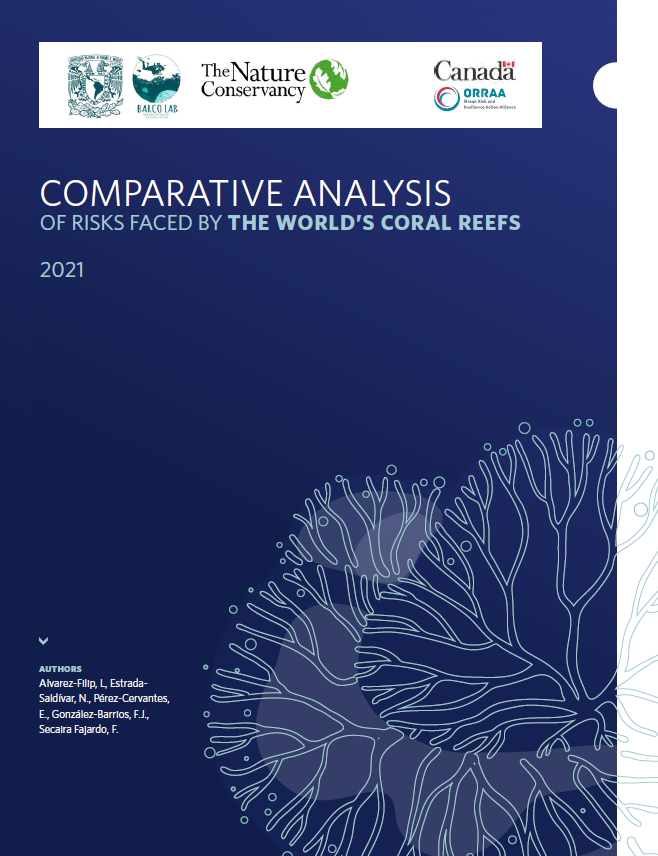Status of Coral Reefs
Coral reefs worldwide are facing severe threats that jeopardize their survival and have already led to degradation and destruction in many places. New management actions are desperately needed to ensure reefs continue to exist and recover their structure and function where that has been compromised. Fortunately, scientists, conservationists, and environmental managers across the globe are developing and implementing new strategies to protect and conserve these ecosystems against a suite of local and global threats.
In addition to understanding and communicating the importance of coral reefs, it is also critically important to understand the status of coral reefs around the world and the extent to which they are at risk.
Below are key findings from the Global Coral Reef Monitoring Network’s Status of Coral Reefs of the World (2020) report that quantifies the current state of knowledge on coral and algal cover on reefs using global monitoring data from 73 countries and 12,000 sites from 1978-2019.
Status of Coral Reefs Worldwide
- Prior to the 1998 mass coral bleaching event, the global average cover of hard coral was high (>30%) and stable, but the 1998 bleaching event caused a loss of 8% of the world’s coral reefs.
- In the decade after the 1998 event, global average hard coral cover returned to pre-1998 levels (33.3% in 2009), suggesting many reefs are resilient and can recover in the absence of major disturbances.
- Since 2009, however, there has been a global decline in coral with a loss of 14% of coral worldwide, equivalent to nearly all the coral on Australia’s coral reefs.
- Two-thirds of the world’s coral reefs are experiencing an increase in algae cover. Prior to 2011, the estimated global average cover of algae was low (~16%) and stable for 30 years. Since then, algae on the world’s coral reefs has increased by 20%, mirroring the decrease in hard coral cover.
- Large scale coral bleaching events are the greatest disturbance to the world’s coral reefs. Declines in global coral cover were associated with rapid increases in sea surface temperatures (SST) or sustained high SST anomalies.
- Until 1997 the ratio of live coral cover to algae cover was stable, with more than twice as much coral than algae on reefs on average. The ratio declined after the 1998 bleaching event but recovered until 2010, after which the ratio has progressively declined. This decline corresponds with both the loss in coral cover and the increase in algae cover observed over the last decade.
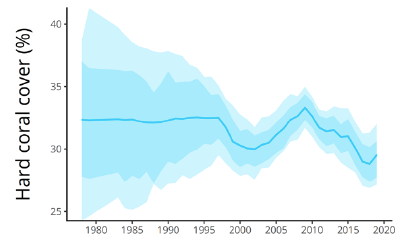
Estimated global average cover of hard coral (solid blue line) and associated 80% (darker shade) and 95% (lighter shade) credible intervals, which represent levels of uncertainty. Source: GCRMN 2020
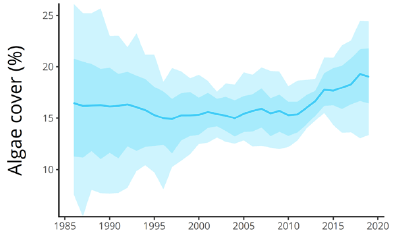
Estimated global average cover of algae (solid blue line) and associated 80% (darker shade) and 95% (lighter shade) credible intervals, which represent levels of uncertainty. Source: GCRMN 2020

Estimated ratio between the global average covers of coral and algae (solid blue line) and associated 80% (darker shade) and 95% (lighter shade) credible intervals, which represent levels of uncertainty. Source: GCRMN 2020
Trends in Different Regions
- Since 2010, almost all regions have experienced a decline in coral cover, with South Asia, Australia, the Pacific, the Regional Organization for the Protection of the Marine Environment), and the East Asian Seas regions exhibiting the greatest declines.
- Most regions have also exhibited an increase in algal cover, particularly in the ROPME Sea Area, Eastern Tropical Pacific, Red Sea, Caribbean, Australia, and Brazil.
- The greatest increases in coral cover were observed in regions where the 1998 coral bleaching event had the greatest impacts, demonstrating the potential for reef resilience and that recovery can occur within a decade.
- The East Asian Seas region, which includes the Coral Triangle, showed distinctly different trends from other regions, where coral cover was substantially greater in 2019 (36.8%) than the earliest data contributed in 1983 (32.8%). Algal cover also decreased, with five times more coral than algae on reefs on average in this region.
- The ratio of average live coral cover to algal cover varied between regions. The ROPME Sea Area, Eastern Tropical Pacific and Caribbean had more algae than coral; the Western Indian Ocean, Australia and Brazil had similar average covers of coral and algae; the South Asia, East Asian Seas, Red Sea and Gulf of Aden and the Pacific regions had at least twice the average cover of coral compared with algae.
- Specific trends for each GCRMN region and subregions can be found in regional chapters of the report.
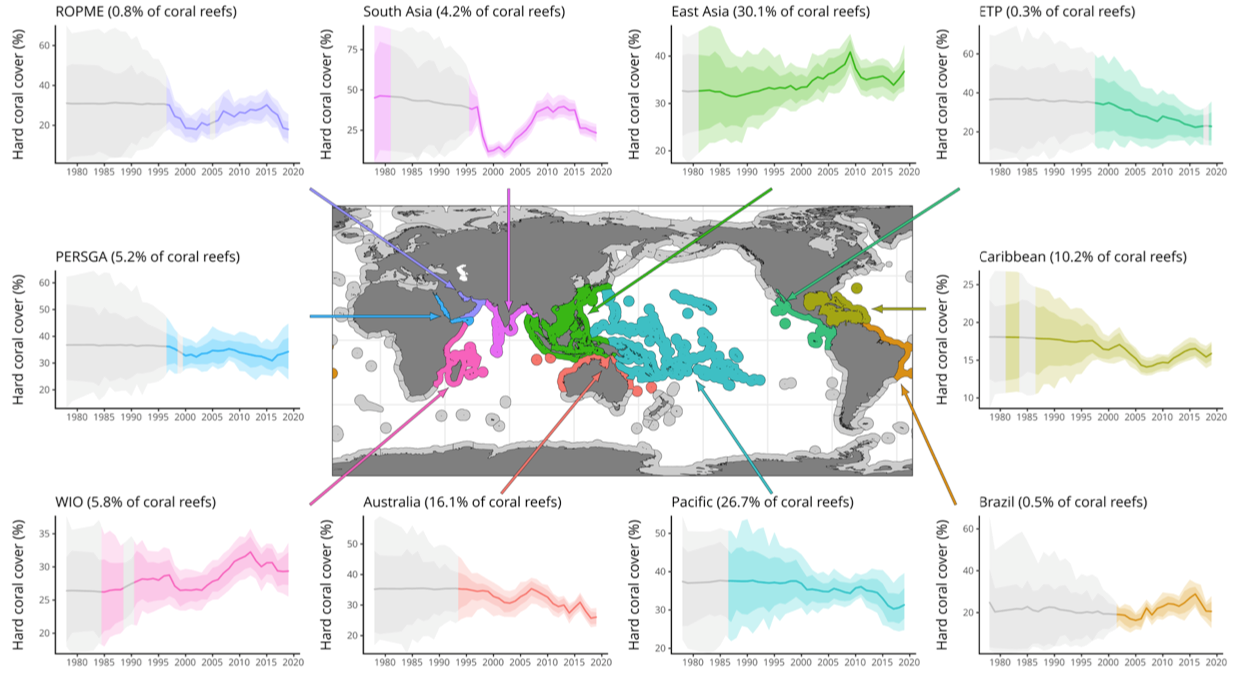
Long-term trends in the average cover of live hard coral in each of the ten GCRMN regions. The solid line represents the estimated mean with 80% (darker shade) and 95% (lighter shade) credible intervals, which represent levels of uncertainty. Grey areas represent periods for which no observed data were available. Trends are coloured to match the GCRMN regions represented on the central map. The proportion of the world's coral reef area supported by each region is indicated by % of coral reefs. ETP is the Eastern Tropical Pacific. PERSGA is the Red Sea and Gulf of Aden. ROPME is the ROPME Sea Area. WIO is the Western Indian Ocean. Source: Global Coral Reef Monitoring Network 2021
Below are key findings from the 2011 Reefs at Risk Revisited report ref that quantified the current threats to coral reefs worldwide and projected the risk of future degradation.
Threats in Different Coral Reef Regions
- Almost 95% of coral reefs in Southeast Asia are threatened.
- Indonesia has the largest area of threatened coral reefs, with fishing threats being the main stressor on coral reefs.
- More than 75% of the coral reefs in the Atlantic are threatened. In over 20 countries and territories in this region, all coral reefs are rated as threatened.
- Over 65% of the coral reefs in the Indian Ocean and the Middle East are under stress by local threats.
- Nearly 50% of coral reefs in the Pacific are threatened.
- Approximately 14% of Australia’s coral reefs are threatened, though it is ranked as the least threatened coral reef region.

This map shows a global classification of coral reefs by the estimated present threat from local human activities, according to Reefs at Risk integrated local threat index. The index includes overfishing and destructive fishing, coastal development, watershed-based pollution, marine-based pollution and damage. Global warming and ocean acidification are not included as they are global, not local threats. Click to enlarge. Map © WRI (World Resources Institute)
Increases in Threats to Coral Reefs
- The percentage of threatened coral reefs increased by 30% in the period from 2000 to 2010.
- Increases have occurred across all local threats and all regions of the world.
- Fishing threats (overfishing and destructive fishing) have increased by 80% in the period from 2000 to 2010, making it the greatest non-climate related stressor facing coral reefs worldwide.
- Mass coral bleaching has now occurred in every region of the world.
- It is projected that during most years in the 2050s, 95% of coral reefs will experience high thermal stress and potential bleaching.
- Due to ocean acidification, it is projected that by 2050 only about 15% of coral reefs will be in areas where aragonite levels are adequate for coral growth.
- 27 countries and territories are identified as highly vulnerable to reef loss across the world’s reef regions; 19 of these are small island states.
It is important to communicate the status of coral reefs on the local level. This information can often be difficult to find or access. For country level information on the threats to reefs you can access the Reefs At Risk website to find reports that include detailed global, regional, and local reef information.
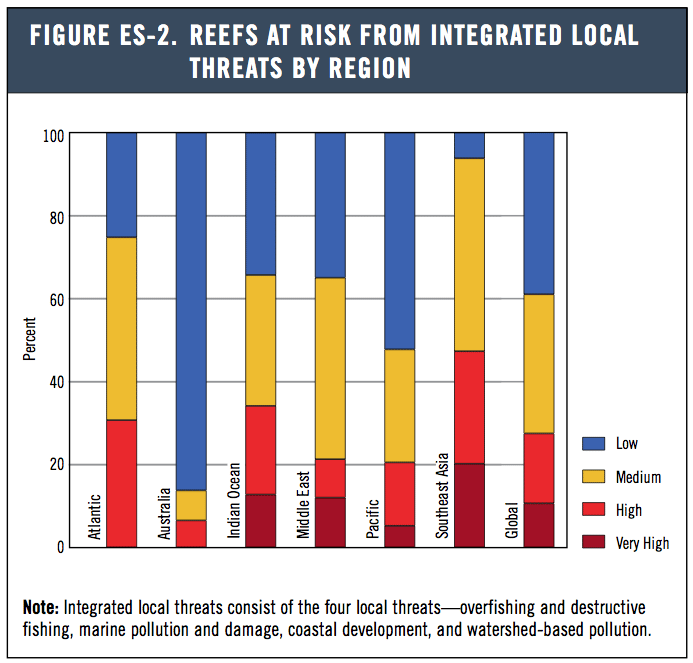
Reefs at risk from integrated local threats by region. Image © WRI (World Resources Institute)
This new report presents the results of an analysis of the severity of impacts to coral reefs to compare their relative importance globally and regionally. Risks were categorized by scale of the impact and frequency of the events.
The results will help decision-makers and reef managers understand the relative importance of the risks coral reefs face.

